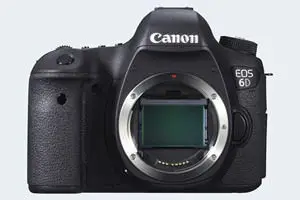Canon 6D vs Sony RX10 IV
The Canon EOS 6D and the Sony Cyber-shot DSC-RX10 IV are two enthusiast cameras that were officially introduced, respectively, in September 2012 and September 2017. The 6D is a DSLR, while the RX10 IV is a fixed lens compact. The cameras are based on a full frame (6D) and an one-inch (RX10 IV) sensor. Both cameras offer a resolution of 20 megapixels.
Below is an overview of the main specs of the two cameras as a starting point for the comparison.

Check 6D offers at
ebay.com

Check RX10 IV price at
amazon.com
Going beyond this snapshot of core features and characteristics, what are the differences between the Canon EOS 6D and the Sony Cyber-shot DSC-RX10 IV? Which one should you buy? Read on to find out how these two cameras compare with respect to their body size, their imaging sensors, their shooting features, their input-output connections, and their reception by expert reviewers.
Body comparison
The physical size and weight of the Canon 6D and the Sony RX10 IV are illustrated in the side-by-side display below. The two cameras are presented according to their relative size. Three successive views from the front, the top, and the rear are shown. All width, height and depth dimensions are rounded to the nearest millimeter.
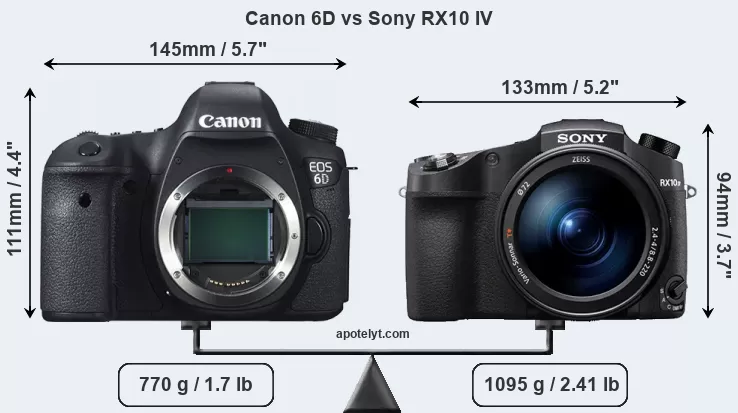
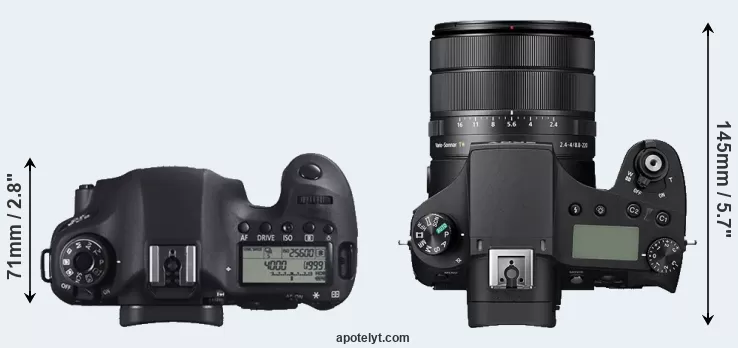
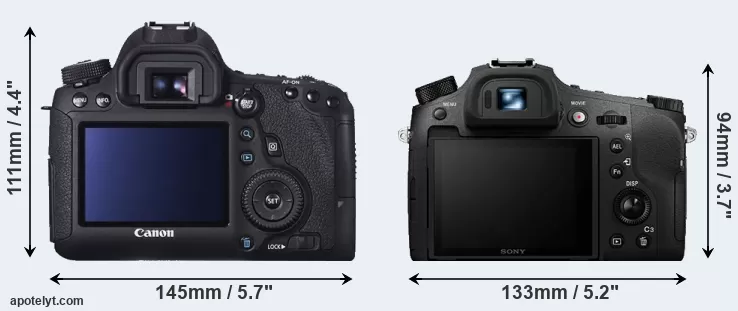
If the front view area (width x height) of the cameras is taken as an aggregate measure of their size, the Sony RX10 IV is notably smaller (22 percent) than the Canon 6D. In this context, it is worth noting that both cameras are splash and dust-proof and can, hence, be used in inclement weather conditions or harsh environments.
The above size and weight comparisons are to some extent incomplete and possibly misleading, as the RX10 IV has a lens built in, whereas the 6D is an interchangeable lens camera that requires a separate lens. Attaching the latter will add extra weight and bulk to the setup. You can compare the optics available for the 6D and their specifications in the Canon EF Lens Catalog.
Concerning battery life, the 6D gets 1090 shots out of its Canon LP-E6 battery, while the RX10 IV can take 400 images on a single charge of its Sony NP-FW50 power pack. The power pack in the RX10 IV can be charged via the USB port, which can be very convenient when travelling.
The table below summarizes the key physical specs of the two cameras alongside a broader set of comparators. In case you want to display and compare another camera duo, you can use the CAM-parator app to select your camera combination among a large number of options.

| Camera Model |
Camera Width |
Camera Height |
Camera Depth |
Camera Weight |
Battery Life |
Weather Sealing |
Camera Launch |
Launch Price |
Street Price |
||
|---|---|---|---|---|---|---|---|---|---|---|---|
| 1. | Canon 6D | 145 mm | 111 mm | 71 mm | 770 g | 1090 | Y | Sep 2012 | US$ 2 099 | ebay.com | |
| 2. | Sony RX10 IV | 133 mm | 94 mm | 145 mm | 1095 g | 400 | Y | Sep 2017 | US$ 1 699 | amazon.com | |
| 3. | Canon 1D X | 158 mm | 168 mm | 83 mm | 1551 g | 1120 | Y | Oct 2011 | US$ 6 799 | ebay.com | |
| 4. | Canon 1D X Mark II | 158 mm | 168 mm | 83 mm | 1530 g | 1210 | Y | Feb 2016 | US$ 5 999 | ebay.com | |
| 5. | Canon 5D Mark II | 152 mm | 114 mm | 75 mm | 850 g | 850 | Y | Sep 2008 | US$ 3 499 | ebay.com | |
| 6. | Canon 5D Mark III | 152 mm | 116 mm | 76 mm | 950 g | 950 | Y | Mar 2012 | US$ 3 499 | ebay.com | |
| 7. | Canon 5DS | 152 mm | 116 mm | 76 mm | 930 g | 700 | Y | Feb 2015 | US$ 3 699 | ebay.com | |
| 8. | Canon 6D Mark II | 144 mm | 111 mm | 75 mm | 765 g | 1200 | Y | Jun 2017 | US$ 1 999 | amazon.com | |
| 9. | Canon 7D II | 149 mm | 112 mm | 78 mm | 910 g | 670 | Y | Sep 2014 | US$ 1 799 | ebay.com | |
| 10. | Canon 70D | 139 mm | 104 mm | 79 mm | 755 g | 920 | Y | Jul 2013 | US$ 1 199 | ebay.com | |
| 11. | Nikon D600 | 141 mm | 113 mm | 82 mm | 850 g | 900 | Y | Sep 2012 | US$ 2 099 | ebay.com | |
| 12. | Nikon D610 | 141 mm | 113 mm | 82 mm | 850 g | 900 | Y | Oct 2013 | US$ 1 999 | ebay.com | |
| 13. | Sony RX10 | 129 mm | 88 mm | 102 mm | 813 g | 420 | Y | Oct 2013 | US$ 1 299 | ebay.com | |
| 14. | Sony RX10 II | 129 mm | 88 mm | 102 mm | 813 g | 400 | Y | Jun 2015 | US$ 1 299 | ebay.com | |
| 15. | Sony RX10 III | 133 mm | 94 mm | 127 mm | 1051 g | 420 | Y | Mar 2016 | US$ 1 499 | ebay.com | |
| 16. | Sony RX100 V | 102 mm | 58 mm | 41 mm | 299 g | 220 | n | Oct 2016 | US$ 999 | ebay.com | |
| 17. | Sony RX100 VI | 102 mm | 58 mm | 43 mm | 301 g | 240 | n | Jun 2018 | US$ 1 199 | ebay.com | |
| Note: Measurements and pricing do not include easily detachable parts, such as add-on or interchangeable lenses or optional viewfinders. | |||||||||||
Any camera decision will naturally be influenced heavily by the price. The manufacturer’s suggested retail prices give an idea on the placement of the camera in the maker’s lineup and the broader market. The RX10 IV was launched at a lower price than the 6D, despite having a lens built in. Usually, retail prices stay at first close to the launch price, but after several months, discounts become available. Later in the product cycle and, in particular, when the replacement model is about to appear, further discounting and stock clearance sales often push the camera price considerably down.
Sensor comparison
The size of the sensor inside a digital camera is one of the key determinants of image quality. A large sensor will generally have larger individual pixels that offer better low-light sensitivity, provide wider dynamic range, and have richer color-depth than smaller pixels in a sensor of the same technological generation. Further, a large sensor camera will give the photographer additional creative options when using shallow depth-of-field to isolate a subject from its background. On the downside, larger sensors tend to be associated with larger, more expensive camera bodies and lenses.
Of the two cameras under consideration, the Canon 6D features a full frame sensor and the Sony RX10 IV an one-inch sensor. The sensor area in the RX10 IV is 87 percent smaller. As a result of these sensor size differences, the cameras have a format factor of, respectively, 1.0 and 2.7. Both cameras have a native aspect ratio (sensor width to sensor height) of 3:2.
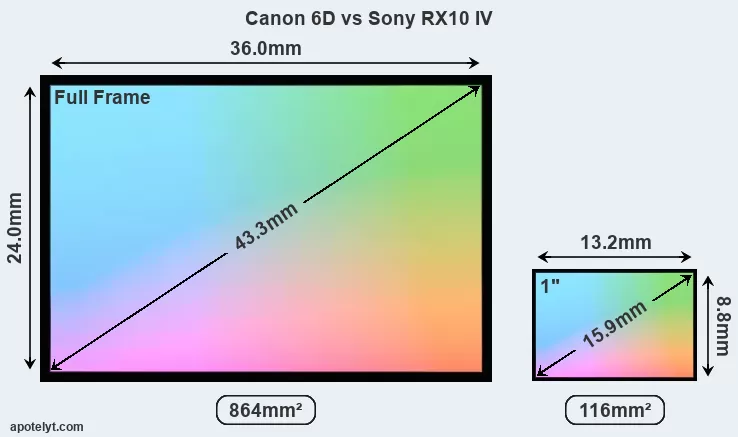
Even though the 6D has a larger sensor, both cameras offer the same resolution of 20 megapixels. This implies that the 6D has a lower pixel density and larger individual pixels (with a pixel pitch of 6.57μm versus 2.41μm for the RX10 IV), which gives it a potential advantage in terms of light gathering capacity. It should, however, be noted that the RX10 IV is much more recent (by 4 years and 11 months) than the 6D, and its sensor will have benefitted from technological advances during this time that at least partly compensate for the smaller pixel size.
The RX10 IV has on-sensor phase detect pixels, which results in fast and reliable autofocus acquisition even during live view operation.
The Canon EOS 6D has a native sensitivity range from ISO 100 to ISO 25600, which can be extended to ISO 50-102400. The corresponding ISO settings for the Sony Cyber-shot DSC-RX10 IV are ISO 100 to ISO 12800, with the possibility to increase the ISO range to 64-25600.
In terms of underlying technology, the 6D is build around a CMOS sensor, while the RX10 IV uses a BSI-CMOS imager. Both cameras use a Bayer filter for capturing RGB colors on a square grid of photosensors. This arrangement is found in most digital cameras.
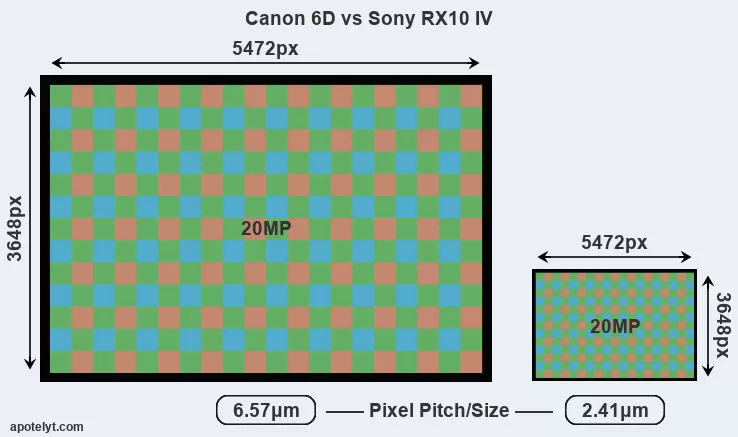
Since 2007, DXO Mark has published sensor performance measurements that have been derived using a consistent methodology. This service assesses and scores the color depth ("DXO Portrait"), dynamic range ("DXO Landscape"), and low-light sensitivity ("DXO Sports") of camera sensors, and also publishes an overall camera score. The adjacent table reports on the physical sensor characteristics and the outcomes of the DXO sensor quality tests for a sample of comparator-cameras.

| Camera Model |
Sensor Class |
Resolution (MP) |
Horiz. Pixels |
Vert. Pixels |
Video Format |
DXO Portrait |
DXO Landscape |
DXO Sports |
DXO Overall |
||
|---|---|---|---|---|---|---|---|---|---|---|---|
| 1. | Canon 6D | Full Frame | 20.0 | 5472 | 3648 | 1080/30p | 23.8 | 12.1 | 2340 | 82 | |
| 2. | Sony RX10 IV | 1-inch | 20.0 | 5472 | 3648 | 4K/30p | 22.0 | 12.2 | 408 | 63 | |
| 3. | Canon 1D X | Full Frame | 17.9 | 5184 | 3456 | 1080/30p | 23.8 | 11.8 | 2786 | 82 | |
| 4. | Canon 1D X Mark II | Full Frame | 20.0 | 5472 | 3648 | 4K/60p | 24.1 | 13.5 | 3207 | 88 | |
| 5. | Canon 5D Mark II | Full Frame | 21.0 | 5616 | 3744 | 1080/30p | 23.7 | 11.9 | 1815 | 79 | |
| 6. | Canon 5D Mark III | Full Frame | 22.1 | 5760 | 3840 | 1080/30p | 24.0 | 11.7 | 2293 | 81 | |
| 7. | Canon 5DS | Full Frame | 50.3 | 8688 | 5792 | 1080/30p | 24.7 | 12.4 | 2381 | 87 | |
| 8. | Canon 6D Mark II | Full Frame | 26.0 | 6240 | 4160 | 1080/60p | 24.4 | 11.9 | 2862 | 85 | |
| 9. | Canon 7D II | APS-C | 20.0 | 5472 | 3648 | 1080/60p | 22.4 | 11.8 | 1082 | 70 | |
| 10. | Canon 70D | APS-C | 20.0 | 5472 | 3648 | 1080/30p | 22.5 | 11.6 | 926 | 68 | |
| 11. | Nikon D600 | Full Frame | 24.2 | 6016 | 4016 | 1080/30p | 25.1 | 14.2 | 2980 | 94 | |
| 12. | Nikon D610 | Full Frame | 24.2 | 6016 | 4016 | 1080/30p | 25.1 | 14.4 | 2925 | 94 | |
| 13. | Sony RX10 | 1-inch | 20.0 | 5472 | 3648 | 1080/60p | 22.9 | 12.6 | 474 | 69 | |
| 14. | Sony RX10 II | 1-inch | 20.0 | 5472 | 3648 | 4K/30p | 23.0 | 12.6 | 531 | 70 | |
| 15. | Sony RX10 III | 1-inch | 20.0 | 5472 | 3648 | 4K/30p | 23.1 | 12.6 | 472 | 70 | |
| 16. | Sony RX100 V | 1-inch | 20.0 | 5472 | 3648 | 4K/30p | 22.8 | 12.4 | 586 | 70 | |
| 17. | Sony RX100 VI | 1-inch | 20.0 | 5472 | 3648 | 4K/30p | 22.1 | 12.3 | 478 | 64 | |
| Note: DXO values in italics represent estimates based on sensor size and age. | |||||||||||
Many modern cameras are not only capable of taking still images, but can also record movies. Both cameras under consideration are equipped with sensors that have a sufficiently high read-out speed for moving images, but the RX10 IV provides a better video resolution than the 6D. It can shoot movie footage at 4K/30p, while the Canon is limited to 1080/30p.
Feature comparison
Apart from body and sensor, cameras can and do differ across a variety of features. For example, the RX10 IV has an electronic viewfinder (2359k dots), while the 6D has an optical one. Both systems have their advantages, with the electronic viewfinder making it possible to project supplementary shooting information into the framing view, whereas the optical viewfinder offers lag-free viewing and a very clear framing image. The viewfinder in the RX10 IV offers a wider field of view (100%) than the one in the 6D (97%), so that a larger proportion of the captured image is visible in the finder. On the other hand, the viewfinder of the 6D has a higher magnification (0.71x vs 0.70x), so that the size of the image transmitted appears closer to the size seen with the naked human eye. The following table reports on some other key feature differences and similarities of the Canon 6D, the Sony RX10 IV, and comparable cameras.

| Camera Model |
Viewfinder (Type or 000 dots) |
Control Panel (yes/no) |
LCD Specifications (inch/000 dots) |
LCD Attach- ment |
Touch Screen (yes/no) |
Max Shutter Speed * |
Max Shutter Flaps * |
Built-in Flash (yes/no) |
Built-in Image Stab |
||
|---|---|---|---|---|---|---|---|---|---|---|---|
| 1. | Canon 6D | optical | Y | 3.0 / 1040 | fixed | n | 1/4000s | 4.5/s | n | n | |
| 2. | Sony RX10 IV | 2359 | Y | 3.0 / 1440 | tilting | Y | 1/2000s | 24.0/s | Y | Y | |
| 3. | Canon 1D X | optical | Y | 3.2 / 1040 | fixed | n | 1/8000s | 14.0/s | n | n | |
| 4. | Canon 1D X Mark II | optical | Y | 3.2 / 1620 | fixed | Y | 1/8000s | 16.0/s | n | n | |
| 5. | Canon 5D Mark II | optical | Y | 3.0 / 920 | fixed | n | 1/8000s | 3.9/s | n | n | |
| 6. | Canon 5D Mark III | optical | Y | 3.2 / 1040 | fixed | n | 1/8000s | 6.0/s | n | n | |
| 7. | Canon 5DS | optical | Y | 3.2 / 1040 | fixed | n | 1/8000s | 5.0/s | n | n | |
| 8. | Canon 6D Mark II | optical | Y | 3.0 / 1040 | swivel | Y | 1/4000s | 6.5/s | n | n | |
| 9. | Canon 7D II | optical | Y | 3.0 / 1040 | fixed | n | 1/8000s | 10.0/s | Y | n | |
| 10. | Canon 70D | optical | Y | 3.0 / 1040 | swivel | Y | 1/8000s | 7.0/s | Y | n | |
| 11. | Nikon D600 | optical | Y | 3.0 / 921 | fixed | n | 1/4000s | 5.5/s | Y | n | |
| 12. | Nikon D610 | optical | Y | 3.2 / 921 | fixed | n | 1/4000s | 6.0/s | Y | n | |
| 13. | Sony RX10 | 1440 | Y | 3.0 / 1229 | tilting | n | 1/3200s | 10.0/s | Y | Y | |
| 14. | Sony RX10 II | 2359 | Y | 3.0 / 1229 | tilting | n | 1/3200s | 14.0/s | Y | Y | |
| 15. | Sony RX10 III | 2359 | Y | 3.0 / 1229 | tilting | n | 1/2000s | 14.0/s | Y | Y | |
| 16. | Sony RX100 V | 2359 | n | 3.0 / 1229 | tilting | n | 1/2000s | 24.0/s | Y | Y | |
| 17. | Sony RX100 VI | 2359 | n | 3.0 / 1229 | tilting | Y | 1/2000s | 24.0/s | Y | Y | |
| Note: *) Information refers to the mechanical shutter, unless the camera only has an electronic one. | |||||||||||
One differentiating feature between the two cameras concerns the touch sensitivity of the rear screen. The RX10 IV has a touchscreen, while the 6D has a conventional panel. Touch control can be particularly helpful, for example, for setting the focus point.
The reported shutter speed information refers to the use of the mechanical shutter. Yet, some cameras only have an electronic shutter, while others have an electronic shutter in addition to a mechanical one. In fact, the RX10 IV is one of those camera that have an additional electronic shutter, which makes completely silent shooting possible. However, this mode is less suitable for photographing moving objects (risk of rolling shutter) or shooting under artificial light sources (risk of flickering).
The 6D writes its imaging data to SDXC cards, while the RX10 IV uses SDXC or Memory Stick PRO Duo cards. Both cameras can use UHS-I cards, which provide for Ultra High Speed data transfer of up to 104 MB/s.
Connectivity comparison
For some imaging applications, the extent to which a camera can communicate with its environment can be an important aspect in the camera decision process. The table below provides an overview of the connectivity of the Canon EOS 6D and Sony Cyber-shot DSC-RX10 IV and, in particular, the interfaces the cameras (and selected comparators) provide for accessory control and data transfer.

| Camera Model |
Hotshoe Port |
Internal Mic / Speaker |
Microphone Port |
Headphone Port |
HDMI Port |
USB Port |
WiFi Support |
NFC Support |
Bluetooth Support |
||
|---|---|---|---|---|---|---|---|---|---|---|---|
| 1. | Canon 6D | Y | mono / mono | Y | - | mini | 2.0 | Y | - | - | |
| 2. | Sony RX10 IV | Y | stereo / mono | Y | Y | micro | 2.0 | Y | Y | - | |
| 3. | Canon 1D X | Y | mono / - | Y | - | mini | 2.0 | - | - | - | |
| 4. | Canon 1D X Mark II | Y | mono / mono | Y | Y | mini | 3.0 | - | - | - | |
| 5. | Canon 5D Mark II | Y | mono / mono | Y | - | mini | 2.0 | - | - | - | |
| 6. | Canon 5D Mark III | Y | mono / mono | Y | Y | mini | 2.0 | - | - | - | |
| 7. | Canon 5DS | Y | mono / mono | Y | - | mini | 3.0 | - | - | - | |
| 8. | Canon 6D Mark II | Y | stereo / mono | Y | - | mini | 2.0 | Y | Y | Y | |
| 9. | Canon 7D II | Y | stereo / mono | Y | Y | mini | 3.0 | - | - | - | |
| 10. | Canon 70D | Y | stereo / mono | Y | - | mini | 2.0 | Y | - | - | |
| 11. | Nikon D600 | Y | mono / mono | Y | Y | mini | 2.0 | - | - | - | |
| 12. | Nikon D610 | Y | mono / mono | Y | Y | mini | 2.0 | - | - | - | |
| 13. | Sony RX10 | Y | stereo / mono | Y | Y | micro | 2.0 | Y | Y | - | |
| 14. | Sony RX10 II | Y | stereo / mono | Y | Y | micro | 2.0 | Y | Y | - | |
| 15. | Sony RX10 III | Y | stereo / mono | Y | Y | micro | 2.0 | Y | Y | - | |
| 16. | Sony RX100 V | - | stereo / mono | - | - | micro | 2.0 | Y | Y | - | |
| 17. | Sony RX100 VI | - | stereo / mono | - | - | micro | 2.0 | Y | Y | Y |
Travel and landscape photographers will find it useful that the 6D has an internal geolocalization sensor and can record GPS coordinates in its EXIF data.
The RX10 IV is a recent model that features in the current product line-up of Sony. In contrast, the 6D has been discontinued (but can be found pre-owned on ebay). As a replacement in the same line of cameras, the 6D was succeeded by the Canon 6D Mark II. Further information on the features and operation of the 6D and RX10 IV can be found, respectively, in the Canon 6D Manual (free pdf) or the online Sony RX10 IV Manual.
Review summary
So how do things add up? Is the Canon 6D better than the Sony RX10 IV or vice versa? Below is a summary of the relative strengths of each of the two contestants.

Arguments in favor of the Canon EOS 6D:
- Better image quality: Features bigger pixels on a larger sensor for higher quality imaging.
- Richer colors: The pixel size advantage translates into images with better, more accurate colors.
- More dynamic range: Larger pixels capture a wider spectrum of light and dark details.
- Better low-light sensitivity: Larger pixels means good image quality even under poor lighting.
- Brighter framing: Features an optical viewfinder for clear, lag-free composition.
- Larger viewfinder image: Features a viewfinder with a higher magnification (0.71x vs 0.70x).
- Faster shutter: Has higher mechanical shutter speed (1/4000s vs 1/2000s) to freeze action.
- More flexible: Can take a variety of interchangeable lenses, including specialty optics.
- Longer lasting: Can take more shots (1090 versus 400) on a single battery charge.
- Easier geotagging: Features an internal GPS sensor to log localization data.
- More heavily discounted: Has been available for much longer (launched in September 2012).

Reasons to prefer the Sony Cyber-shot DSC-RX10 IV:
- Better video: Provides higher definition movie capture (4K/30p vs 1080/30p).
- Better live-view autofocus: Features on-sensor phase-detection for more confident autofocus.
- Better sound control: Has a headphone port that enables audio monitoring while recording.
- More framing info: Has an electronic viewfinder that displays shooting data.
- More complete view: Has a viewfinder with a larger field of view (100% vs 97%).
- More detailed LCD: Has a higher resolution rear screen (1440k vs 1040k dots).
- More flexible LCD: Has a tilting screen for odd-angle shots in landscape orientation.
- Fewer buttons to press: Has a touchscreen to facilitate handling and shooting adjustments.
- Faster burst: Shoots at higher frequency (24 vs 4.5 flaps/sec) to capture the decisive moment.
- Less disturbing: Has an electronic shutter option for completely silent shooting.
- Ready to shoot: Comes with an integrated lens, while the 6D requires a separate lens.
- More compact: Is smaller (133x94mm vs 145x111mm) and will fit more readily into a bag.
- Easier travel charging: Can be conveniently charged via its USB port.
- Sharper images: Has stabilization technology built-in to reduce the impact of hand-shake.
- Easier fill-in: Has a small integrated flash to brighten shadows of backlit subjects.
- Easier device pairing: Supports NFC for fast wireless image transfer over short distances.
- More affordable: Was introduced at a lower price, despite coming with a built-in lens.
- More modern: Reflects 4 years and 11 months of technical progress since the 6D launch.
If the count of relative strengths (bullet points above) is taken as a measure, the RX10 IV is the clear winner of the contest (18 : 11 points). However, the relevance of individual strengths will vary across photographers, so that you might want to apply your own weighing scheme to the summary points when reflecting and deciding on a new camera. A professional wildlife photographer will view the differences between cameras in a way that diverges from the perspective of a family photog, and a person interested in architecture has distinct needs from a sports shooter. Hence, the decision which camera is best and worth buying is often a very personal one.
How about other alternatives? Do the specifications of the Canon 6D and the Sony RX10 IV place the cameras among the top in their class? Find out in the latest Best DSLR Camera and Best Superzoom Camera listings whether the two cameras rank among the cream of the crop.
In any case, while the comparison of technical specifications can provide a useful overview of the capabilities of different cameras, it remains partial and cannot reveal, for example, the shooting experience and imaging performance when actually working with the 6D or the RX10 IV. User reviews, such as those found at amazon, can sometimes inform about these issues, but such feedback is often incomplete, inconsistent, and biased.
Expert reviews
This is why hands-on reviews by experts are important. The table below provides a synthesis of the camera assessments of some of the best known photo-gear review sites (amateurphotographer [AP], cameralabs [CL], digitalcameraworld [DCW], dpreview [DPR], ephotozine [EPZ], photographyblog [PB]). As can be seen, the professional reviewers agree in many cases on the quality of different cameras, but sometimes their assessments diverge, reinforcing the earlier point that a camera decision is often a very personal choice.

| Camera Model |
AP score |
CL score |
DCW score |
DPR score |
EPZ score |
PB score |
Camera Launch |
Launch Price |
Street Price |
||
|---|---|---|---|---|---|---|---|---|---|---|---|
| 1. | Canon 6D | 5/5 | + + | .. | 83/100 | 4.5/5 | 4.5/5 | Sep 2012 | US$ 2 099 | ebay.com | |
| 2. | Sony RX10 IV | 5/5 | + | 3.5/5 | 84/100 | 4.5/5 | 5/5 | Sep 2017 | US$ 1 699 | amazon.com | |
| 3. | Canon 1D X | 5/5 | .. | .. | .. | 4.5/5 | 4.5/5 | Oct 2011 | US$ 6 799 | ebay.com | |
| 4. | Canon 1D X Mark II | .. | .. | 4.5/5 | 89/100 | 4.5/5 | 4.5/5 | Feb 2016 | US$ 5 999 | ebay.com | |
| 5. | Canon 5D Mark II | 4/5 | 91/100 | .. | 79/100 | 4/5 | .. | Sep 2008 | US$ 3 499 | ebay.com | |
| 6. | Canon 5D Mark III | .. | + + | .. | 82/100 | 4.5/5 | 4.5/5 | Mar 2012 | US$ 3 499 | ebay.com | |
| 7. | Canon 5DS | .. | + | .. | 83/100 | 4.5/5 | 4.5/5 | Feb 2015 | US$ 3 699 | ebay.com | |
| 8. | Canon 6D Mark II | 4/5 | + | 4/5 | 80/100 | 4.5/5 | 4/5 | Jun 2017 | US$ 1 999 | amazon.com | |
| 9. | Canon 7D II | 4.5/5 | + | 3.5/5 | 84/100 | 4/5 | 4.5/5 | Sep 2014 | US$ 1 799 | ebay.com | |
| 10. | Canon 70D | 5/5 | + + | .. | 83/100 | 4.5/5 | 5/5 | Jul 2013 | US$ 1 199 | ebay.com | |
| 11. | Nikon D600 | 4/5 | + + | .. | 87/100 | 5/5 | 4.5/5 | Sep 2012 | US$ 2 099 | ebay.com | |
| 12. | Nikon D610 | 4/5 | + + | .. | 87/100 | 4.5/5 | 4.5/5 | Oct 2013 | US$ 1 999 | ebay.com | |
| 13. | Sony RX10 | 5/5 | + | .. | 80/100 | 4.5/5 | 4.5/5 | Oct 2013 | US$ 1 299 | ebay.com | |
| 14. | Sony RX10 II | 5/5 | + + | .. | 82/100 | 4.5/5 | 4/5 | Jun 2015 | US$ 1 299 | ebay.com | |
| 15. | Sony RX10 III | 5/5 | + | .. | 84/100 | 4.5/5 | 4.5/5 | Mar 2016 | US$ 1 499 | ebay.com | |
| 16. | Sony RX100 V | 4.5/5 | + + | .. | 83/100 | 4/5 | 4.5/5 | Oct 2016 | US$ 999 | ebay.com | |
| 17. | Sony RX100 VI | 4.5/5 | + + | .. | 83/100 | 4/5 | 4.5/5 | Jun 2018 | US$ 1 199 | ebay.com | |
| Note: (+ +) highly recommended; (+) recommended; (o) reviewed; (..) not available. | |||||||||||
The review scores listed above should be treated with care, though. The ratings were established in reference to similarly priced cameras that were available in the market at the time of the review. Hence, a score should always be seen in the context of the camera's market launch date and its price, and rating-comparisons among cameras that span long time periods or concern very differently equipped models make little sense. It should also be noted that some of the review sites have over time altered the way they render their verdicts.

Check 6D offers at
ebay.com

Check RX10 IV price at
amazon.com
Other camera comparisons
Did this review help to inform your camera decision process? In case you would like to check on the differences and similarities of other camera models, just make your choice using the following search menu. There is also a set of direct links to comparison reviews that other users of the CAM-parator app explored.
- Canon 6D vs Canon M200
- Canon 6D vs Canon R7
- Canon 6D vs Canon SX70
- Canon 6D vs Fujifilm X-E3
- Canon 6D vs Leica X Typ 113
- Canon 6D vs Nikon D5500
- Fujifilm X100 vs Sony RX10 IV
- Leica D-LUX 6 vs Sony RX10 IV
- Nikon D2Xs vs Sony RX10 IV
- Olympus E-M1X vs Sony RX10 IV
- Panasonic S5 II vs Sony RX10 IV
- Ricoh WG-6 vs Sony RX10 IV
Specifications: Canon 6D vs Sony RX10 IV
Below is a side-by-side comparison of the specs of the two cameras to facilitate a quick review of their differences and common features.
| Camera Model | Canon 6D | Sony RX10 IV |
|---|---|---|
| Camera Type | Digital single lens reflex | Fixed lens compact camera |
| Camera Lens | Canon EF mount lenses | 24-600mm f/2.4-4.0 |
| Launch Date | September 2012 | September 2017 |
| Launch Price | USD 2,099 | USD 1,699 |
| Sensor Specs | Canon 6D | Sony RX10 IV |
| Sensor Technology | CMOS | BSI-CMOS |
| Sensor Format | Full Frame Sensor | 1" Sensor |
| Sensor Size | 36.0 x 24.0 mm | 13.2 x 8.8 mm |
| Sensor Area | 864 mm2 | 116.16 mm2 |
| Sensor Diagonal | 43.3 mm | 15.9 mm |
| Crop Factor | 1.0x | 2.7x |
| Sensor Resolution | 20 Megapixels | 20 Megapixels |
| Image Resolution | 5472 x 3648 pixels | 5472 x 3648 pixels |
| Pixel Pitch | 6.57 μm | 2.41 μm |
| Pixel Density | 2.31 MP/cm2 | 17.18 MP/cm2 |
| Moiré control | Anti-Alias filter | Anti-Alias filter |
| Movie Capability | 1080/30p Video | 4K/30p Video |
| ISO Setting | 100 - 25,600 ISO | 100 - 12,800 ISO |
| ISO Boost | 50 - 102,400 ISO | 64 - 25,600 ISO |
| Image Processor | DIGIC 5+ | BIONZ X |
| DXO Sensor Quality (score) | 82 | .. |
| DXO Color Depth (bits) | 23.8 | .. |
| DXO Dynamic Range (EV) | 12.1 | .. |
| DXO Low Light (ISO) | 2340 | .. |
| Screen Specs | Canon 6D | Sony RX10 IV |
| Viewfinder Type | Optical viewfinder | Electronic viewfinder |
| Viewfinder Field of View | 97% | 100% |
| Viewfinder Magnification | 0.71x | 0.70x |
| Viewfinder Resolution | 2359k dots | |
| Top-Level Screen | Control Panel | Control Panel |
| LCD Framing | Live View | Live View |
| Rear LCD Size | 3.0inch | 3.0inch |
| LCD Resolution | 1040k dots | 1440k dots |
| LCD Attachment | Fixed screen | Tilting screen |
| Touch Input | no Touchscreen | Touchscreen |
| Shooting Specs | Canon 6D | Sony RX10 IV |
| Focus System | Phase-detect AF | On-Sensor Phase-detect |
| Manual Focusing Aid | no Peaking Feature | Focus Peaking |
| Max Shutter Speed (mechanical) | 1/4000s | 1/2000s |
| Continuous Shooting | 4.5 shutter flaps/s | 24 shutter flaps/s |
| Electronic Shutter | no E-Shutter | up to 1/32000s |
| Fill Flash | no On-Board Flash | Built-in Flash |
| Storage Medium | SDXC cards | MS or SDXC cards |
| Single or Dual Card Slots | Single card slot | Single card slot |
| UHS card support | UHS-I | UHS-I |
| Connectivity Specs | Canon 6D | Sony RX10 IV |
| External Flash | Hotshoe | Hotshoe |
| USB Connector | USB 2.0 | USB 2.0 |
| HDMI Port | mini HDMI | micro HDMI |
| Microphone Port | External MIC port | External MIC port |
| Headphone Socket | no Headphone port | Headphone port |
| Wifi Support | Wifi built-in | Wifi built-in |
| Near-Field Communication | no NFC | NFC built-in |
| Geotagging | GPS built-in | no internal GPS |
| Body Specs | Canon 6D | Sony RX10 IV |
| Environmental Sealing | Weathersealed body | Weathersealed body |
| Battery Type | Canon LP-E6 | Sony NP-FW50 |
| Battery Life (CIPA) | 1090 shots per charge | 400 shots per charge |
| In-Camera Charging | no USB charging | USB charging |
| Body Dimensions |
145 x 111 x 71 mm (5.7 x 4.4 x 2.8 in) |
133 x 94 x 145 mm (5.2 x 3.7 x 5.7 in) |
| Camera Weight | 770 g (27.2 oz) | 1095 g (38.6 oz) |

Check 6D offers at
ebay.com

Check RX10 IV price at
amazon.com
Did you notice an error on this page? If so, please get in touch, so that we can correct the information.
